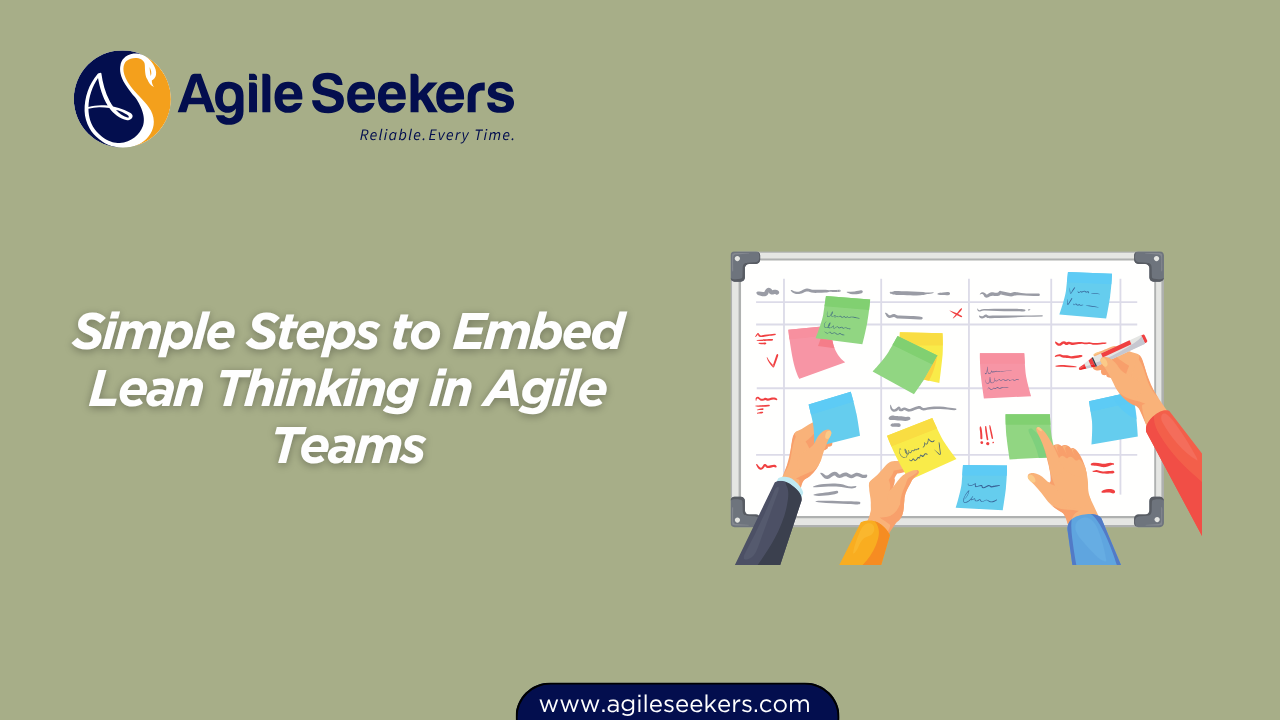Simple Steps to Embed Lean Thinking in Agile Teams

1. Start with Customer Value. Every Time.
At the core of Lean thinking is this idea, don’t waste time on things the customer doesn’t care about. In Agile, it’s easy to get distracted by backlogs, meetings, and frameworks. Cut through that by making customer value your North Star.
-
In sprint planning, ask: Which backlog items deliver the most value to our users right now?
-
In reviews, focus feedback on what actually moved the needle for customers.
This approach is central to Lean-Agile leadership and is also covered in depth in the Leading SAFe Agilist Certification Training. If you want your team’s efforts to mean something, keep customer value at the center of every conversation.
For more context, see the Lean Enterprise article by Harvard Business Review.
2. Visualize Work: Make the Invisible Visible
If you can’t see your work, you can’t improve it. Lean teams use Kanban boards, sprint boards, or even simple wall charts.
-
Map out your workflow from “To Do” to “Done.”
-
Show blockers, work-in-progress, and waiting states.
Transparency forces teams to confront waste, bottlenecks, and rework.
This practice is not just for Kanban teams; Scrum teams benefit just as much, especially when aiming for high performance—something you’ll master in the SAFe Scrum Master Certification.
Pro tip: Physical boards work wonders in co-located teams; for remote teams, keep digital boards up-to-date and visible to everyone. Check out Atlassian’s guide to Kanban boards for a quick overview.
3. Relentlessly Remove Waste
Lean is obsessed with eliminating waste—any activity that doesn’t create value. Waste takes many forms:
-
Extra features nobody uses (overproduction)
-
Waiting for approvals (delays)
-
Too many handoffs (motion)
-
Work piling up (inventory)
-
Defects and rework
Do regular retrospectives with a sharp eye for these waste types. Ask, What slowed us down? What did we build or do that nobody needed?
Don’t just discuss—commit to one thing you’ll stop doing next sprint.
Teams that embrace this thinking often have strong Product Owners and Product Managers. For a deep dive, consider the SAFe Product Owner/Product Manager POPM Certification.
4. Limit Work in Progress (WIP): Stop Starting, Start Finishing
Most teams try to multitask their way to productivity. Here’s the thing—multitasking just dilutes focus and increases context switching.
-
Set a Work in Progress (WIP) limit for your team.
-
Only pull in new work when something gets finished.
When WIP goes down, flow goes up. Features move to production faster, and quality improves. This principle is a foundation of Lean and is critical in frameworks like SAFe. It’s also a topic covered in the SAFe Advanced Scrum Master Certification Training.
5. Build Quality In—Don’t Bolt It On Later
Lean doesn’t treat quality as a checkpoint at the end. Quality gets built into every step of delivery.
-
Use automation for tests and deployments.
-
Do pair programming or peer reviews.
-
Catch bugs early, not in production.
This isn’t about slowing down—it’s about speeding up by avoiding rework.
Release Train Engineers (RTEs) in large organizations help coach this discipline across Agile Release Trains, a topic covered in SAFe Release Train Engineer Certification Training.
6. Empower Teams and Decentralize Decision-Making
Lean thrives when people closest to the work make decisions quickly.
-
Give teams the authority to try, fail, and learn without waiting for endless approvals.
-
Leaders should set direction and clear constraints—not micromanage.
This shift is a hallmark of modern Agile organizations and is a recurring theme in Leading SAFe Agilist Certification Training.
7. Establish Fast Feedback Loops
Shorten feedback cycles everywhere:
-
Get feedback from users early (alpha, beta releases).
-
Use automation to get test results fast.
-
Run demos often—not just at the end of a sprint.
Teams that learn quickly outpace the ones that wait for “perfect” releases.
This loop connects directly to the SAFe Scrum Master Certification, where Scrum Masters act as facilitators for rapid, transparent feedback.
8. Pursue Continuous Improvement (Kaizen)
Lean is not a one-and-done change.
-
Run regular retrospectives.
-
Experiment with new practices.
-
Measure, learn, and adapt.
What really matters is building the habit of never settling.
If teams finish a sprint and feel like everything went perfectly, dig deeper—you probably missed something.
Certification connection: The relentless pursuit of improvement is embedded in the SAFe Advanced Scrum Master Certification Training.
9. Optimize the Whole, Not Just the Parts
Don’t let teams become siloed, optimizing only their local tasks. Lean urges us to look at the entire value stream.
-
Map out the full workflow, from idea to customer delivery.
-
Identify bottlenecks that slow down the system, not just a single team.
Value Stream thinking is at the heart of roles like Release Train Engineers. Learn how to connect teams and remove end-to-end bottlenecks in the SAFe Release Train Engineer Certification Training.
Wrapping Up: Make Lean Thinking Real, Not Ritual
Lean thinking isn’t another process to memorize—it’s a mindset. The difference is in how your team talks about work, solves problems, and improves every day.
-
Keep the customer at the center.
-
Make work visible and kill waste.
-
Limit WIP and build quality into everything.
-
Decentralize decisions and keep feedback fast.
-
Never stop improving.
-
Connect teams to the whole value stream.
If you want to dive deeper into these Lean-Agile practices, there’s real value in formal training—especially the Leading SAFe Agilist Certification Training, SAFe Product Owner/Product Manager POPM Certification, SAFe Scrum Master Certification, SAFe Advanced Scrum Master Certification Training, and SAFe Release Train Engineer Certification Training.
Ready to put Lean thinking into practice? Start with one small change. See what happens. Keep going.
Also read - How SAFe Core Values Drive Business Agility
Also see - Aligning Teams Around SAFe Principles for Better Outcomes




















